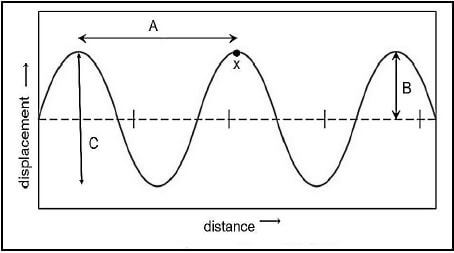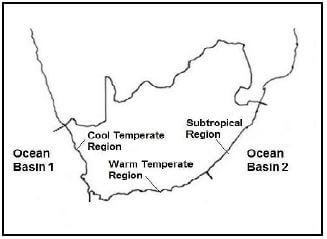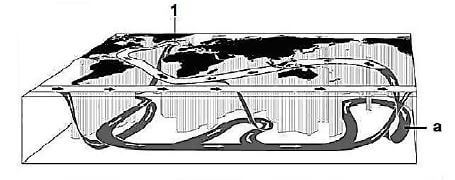MARINE SCIENCES PAPER 1 GRADE 12 QUESTIONS - NSC PAST PAPERS AND MEMOS NOVEMBER 2021
Share via Whatsapp Join our WhatsApp Group Join our Telegram GroupINSTRUCTIONS AND INFORMATION
Read the following instructions carefully before answering the questions.
- This question paper consists of THREE sections. Answer the questions as follows:
SECTION A: COMPULSORY
SECTION B: Consists of QUESTIONS 2 and 3.
Answer BOTH questions in this section.
SECTION C: Consists of QUESTIONS 4 and 5.
Answer any ONE of the two questions in this section. - Write ALL the answers in the ANSWER BOOK.
- Start the answer to EACH question at the top of a NEW page.
- Number the answers correctly according to the numbering system used in this question paper.
- Present your answers according to the instructions of each question.
- Do ALL drawings in pencil and label them in blue or black ink.
- Draw diagrams, tables or flow charts only when asked to do so.
- The diagrams in this question paper are NOT necessarily drawn to scale.
- Do NOT use graph paper.
- You must use a non-programmable calculator, protractor and a compass, where necessary.
- Write neatly and legibly.
QUESTIONS
SECTION A
QUESTION 1
1.1 Various options are provided as possible answers to the following questions. Choose the answer and write only the letter (AD) next to the question numbers (1.1.1 to 1.1.10) in the ANSWER BOOK, e.g. 1.1.11 D.
1.1.1 The lower eulittoral zone on a rocky shore will be exposed at …
- spring low tide.
- neap high tide.
- spring high tide.
- neap low tide.
1.1.2 Pill bugs and sand lice are found in abundance in the upper zone of sandy beaches of the …
- entire South African coast.
- West and South Coasts of South Africa.
- East Coast of South Africa only.
- West Coast of South Africa only.
1.1.3 The balance between the energy radiating to the Earth from the sun and the energy radiating from the Earth back into space:
- The greenhouse effect
- Energy balance
- Climate change
- Global warming
1.1.4 Harvesting energy from tides in South Africa is not viable as …
- the tidal range is too small.
- coastal winds are too strong.
- the wave action is too great.
- the salinity of the water is too high.
1.1.5 The continuous area of water that the wind blows across in a consistent direction:
- Amplitude
- Shoreline
- Fetch
- Predominant area
1.1.6 A company develops a prototype wave generator.
Which of the following does NOT form part of the research and development costs?
- The cost of renting a laboratory
- Researchers' fees
- Test costs
- Maintenance costs
1.1.7 Which ONE of the combinations below shows what happens if a balloon is held in a warm car?
| KINETIC ENERGY OF GAS MOLECULES | VOLUME OF BALLOON | |
| A | Decreases | Decreases |
| B | Increases | Decreases |
| C | Increases | Increases |
| D | Decreases | Increases |
1.1.8 Polysaccharide extracted from red marine algae and used in some brands of toothpaste:
- Carrageenan
- Beta-carotene
- Algin
- Agar
1.1.9 According to the Köppen-Geiger climate system, a location that is temperate, has dry summers and is considered to be very hot, will be classified as …
- Cfd.
- Csa.
- Csc.
- Cwa.
1.1.10 A diver descends with a balloon containing 8 litres of air at the surface, to 30 m below the surface.
What volume will the gas in the balloon occupy at 30 m below sea level?
- 2 litres
- 2,6 litres
- 4 litres
- 8 litres (10 x 2)
(20)
1.2 Give the correct scientific term/phrase for each of the following descriptions. Write only the term next to the question numbers (1.2.1 to 1.2.7) in the ANSWER BOOK.
1.2.1 A low shore eulittoral zone characterised by dome-shaped argenvillei limpets
1.2.2 Organisms that use CaCO3 and Ca ions in dissolved ocean water to construct shells and skeletons
1.2.3 The water from a wave moving up a beach profile
1.2.4 The carbonate mineral CaCO3 used in biological processes to build up parts of the body
1.2.5 The farming of marine organisms
1.2.6 The almost microscopic heterotrophs in soil or sediment ecosystems
1.2.7 A mechanism through which mechanical energy is converted into electrical energy (7 x 1) (7)
1.3 Indicate whether each of the terms in COLUMN I apply to A ONLY, B ONLY, BOTH A AND B or NONE of the items in COLUMN II. Write A only, B only, both A and B, or none next to the question numbers (1.3.1 to 1.3.4) in the ANSWER BOOK.
| COLUMN I | COLUMN II |
| 1.3.1 Pinnacle point | A: Reed fish traps B: Middens |
| 1.3.2 Cochlear zone | A: Lower eulittoral zone B: South Coast |
| 1.3.3 Abiotic factor | A: Available O2 B: Predation |
| 1.3.4 Ocean acidification | A: Increased absorption of greenhouse gases B: Lower pH |
(4 x 2) (8)
1.4 The diagram below represents the anatomy of a wave as found in the ocean. Study the diagram to answer the questions that follow.
[Source: https:/en.m.wikibooks.org/wiki/File:Wave_characteristics.svg]
1.4.1 Label distances A and B. (2)
1.4.2 Label point x on the wave. (1)
1.4.3 Give the LETTER and NAME of the property of the wave that would decrease when a wave moves from deeper water into a much shallower area. (2)
(5)
TOTAL SECTION A: 40
SECTION B
QUESTION 2
2.1 A group of scientists did a study to determine the effect of exposure time on the mass of two mollusc species found on a rocky shore.
The scientists used the following method:
- Collected 15 individuals of each species and placed them into three groups of 5 (Groups 1, 2 and 3)
- Recorded the average initial mass for each individual
- Placed each group of 5 into a desiccator (apparatus which dries them out)
- Left each group in the desiccator for different lengths of time (Group 1 for 2 hours, Group 2 for 4 hours and Group 3 for 6 hours)
- Recorded the final mass for each group
- Recorded the average percentage change in mass for each group
They recorded the results of the study as shown in the table below.
Effect of exposure time on the average percentage weight loss in two mollusc species
| EXPOSURE TIME (HOURS) | AVERAGE PERCENTAGE (%) CHANGE IN MASS | |
| SPECIES A | SPECIES B | |
| 2 | 12 | 3 |
| 4 | 24 | 6 |
| 6 | 45 | 15 |
2.1.1 Identify the dependent variable. (1)
2.1.2 Give a suitable hypothesis for this investigation. (2)
2.1.3 Draw a bar graph to illustrate the data for both species as provided in the table above. (9)
2.1.4 Using the data provided, identify the species that would likely be found in the:
- Middle eulittoral zone (1)
- Lower eulittoral zone (1)
2.1.5 Explain your answers to QUESTION 2.1.4(a) and (b) above. (4)
(18)
2.2 The map below indicates the coastline of southern Africa. Study the map to answer the questions that follow.
2.2.1 Label Ocean Basin 2. (1)
2.2.2 In which ONE of the regions does upwelling events occur mostly in summer? (1)
2.2.3 Describe the phrase Ekman transport. (3)
2.2.4 Explain how Ekman transport contributes to the upwelling events stated in QUESTION 2.2.2. (4)
2.2.5 Compare the nutrient content of the coastal water in the Cool Temperate Region with that of the Subtropical Region. Also compare the effect of the nutrient content on the population sizes of species found in both regions. (4)
(13)
2.3
| Human inventions have been inspired by observing adaptations of organisms in their natural environment. An example of this is wave-powered electricity generators. To ensure that these systems are anchored to the seafloor, designers have taken inspiration from kelp holdfasts. |
2.3.1 Name the design process discussed in the text above. (1)
2.3.2 Why would the designers consider the kelp holdfast as a good research subject to investigate as an anchor for these generators? (3)
2.3.3 Name TWO other challenges of generating energy from the ocean, apart from the challenge stated in QUESTION 2.3.2. (2 )
2.3.4 Seaweed has other commercial applications as well.
Name THREE compounds that can be extracted from seaweed for commercial use as gelling agents. (3) (9)
[40]
QUESTION 3
3.1 South Africa has a coastline of about 3 650 km. Many different ecosystems are found along this coastline. About 27% is rocky shore, 42% sandy beach and 31% mixed shores.
[Source: Griffiths et al. 2010]
3.1.1 Sandy beaches are categorised mainly in two groups based on their gradient.
Analyse how the energy of the waves and currents influence the gradient of the beach. (4)
3.1.2 When visiting the beach, one often sees the plough snails (Bullia species) feeding on dead organisms close to the shoreline.
Explain how these snails make use of the tides to get to their food. (4)
(8)
3.2 Read the passage about corrosion below and answer the questions that follow.
| Corrosion is the chemical action of sea water. The acids in the salt water slowly dissolve rocks on the coast. Limestone and chalk are particularly prone to this process. When insoluble calcium carbonate is treated with carbonic acid, the former dissolves to give a colourless aqueous solution of calcium bicarbonate. |
3.2.1 Define the term corrosion in this passage. (1)
3.2.2 Write down the chemical formula for carbonic acid. (1)
3.2.3 State how acid is formed in the ocean. (1)
3.2.4 A study shows that the amount of CO2 in the ocean is increasing.
Describe how these increased amounts of CO2 would impact coastal formations made of limestone. (2)
(5)
3.3 Read the extract below about the Prince Edward Island Marine Protected Area and answer the questions that follow.
The Prince Edward Island Marine Protected Area (MPA) is an offshore conservation region near the Prince Edward Islands in the Exclusive Economic Zone of South Africa, nearly 2 000 km south-east of South Africa in the Indian Ocean. This MPA provides a habitat for seals, killer whales, breeding seabirds and Patagonian toothfish. [Adapted from https://en.wikipedia.org/wiki/Prince_Edward_Islands_Marine_Protected_Area] |
3.3.1 Under which category of Marine Protected Areas does the Prince Edward Islands group fall? (1)
3.3.2 Name TWO criteria for the category in your answer to QUESTION 3.3.1 above. (2)
(3)
3.4 The schematic diagram below shows the three-dimensional movement of what is often referred to as the 'global conveyer belt'.
Study the diagram below and answer the questions that follow.
3.4.1 Name this global large-scale current. (1)
3.4.2 State whether the water is WARM or COLD at location a. (1)
3.4.3 Analyse the effect of a warming climate at 1 on this circulation pattern. (3)
3.4.4 Explain how differences in the temperature of water masses can be used as a renewable resource. (3)
3.4.5 In which geographical region would the renewable resource stated in QUESTION 3.4.4 be most effective? Explain your answer. (3)
(11)
3.5 Read the extract about weather patterns below and answer the questions that follow.
As human-caused climate change disrupts weather patterns around the world, one overarching question is the subject of increased scientific focus: how will it affect one of the world’s dominant weather-makers? [Adapted from NOAA Research News: How will climate change change El Niño and La Niña?, 9 November 2020] |
3.5.1 State how climate change will affect the frequency of extreme El Niño and La Niña events. (1)
3.5.2 State how this change in the frequency of El Niño events would affect the Amazon region. (1)
3.5.3 Explain how a change in the frequency of El Niño events would lead to an increase in hydrogen sulphide in the waters off the Peruvian coast. (3)
3.5.4 State THREE impacts of La Niña. (3)
3.5.5 Explain how a change in the frequency of La Niña events would change the conditions for organisms living in rock pools in the upper eulittoral zone of rocky shores along the coast of Mozambique. (5)
(13)
[40]
TOTAL SECTION B: 80
SECTION C
Answer any ONE question in this section.
Clearly indicate the QUESTION NUMBER of the chosen question.
NOTE:
Your answer must be in the form of an essay. NO marks will be awarded for answers in the form of a table, flow charts or diagrams.
QUESTION 4
| Area A is located along the west coast of South Africa where a river flows into the ocean. A small town is located on the one side of the river while there is a lagoon on the other side of the river. Most breadwinners of the town are fishers. Recently the populations of fish species seem to have decreased so much that fishing is no longer economically viable, resulting in the fishers experiencing financial difficulties. As a marine scientist, you have been requested to do an environmental impact assessment on the feasibility of creating a biosphere reserve. During your visit, you realise that some members of the community are excited about the potential reserve while others, especially some fishers, are concerned. |
Write an essay in preparation for an address to the local community in which you include the following aspects:
- Define the concept of a biosphere reserve.
- Explain how you intend to estimate the current fish stock along the West Coast using the Catch per Unit Effort method. In your answer, also state which decision variables need to be included.
- Explain how the lagoon could potentially be suitable as an area for recreational fishing as well as ecotourism.
- Discuss the principles and guidelines of The International Ecotourism Society (TIES) that would need to be followed if ecotourism is to be encouraged in the area.
- Elaborate on both the possible reasons why some members of the community would be in favour of the establishment of a reserve, while other members might be against the reserve.
Include an introduction and a conclusion which reflect your point of view.
Content: (25)
Synthesis: (5)
[30]
QUESTION 5
Robben Island is of historical relevance and is conserved as a Category 3 Marine Protected Area. It also has significant ecological importance due to large proportions of populations of seabirds breeding on the island, including more than 3 000 breeding pairs of endangered Cape Cormorants. Many local and international tourists explore the island and its surrounding ecosystems, such as the kelp forests. An integrated conservation management plan has been developed for the island. [Adapted from https://sanccob.co.za/cape-cormorant-chick-rescue-operation/] |
Write an essay in which you consider the environmental health of the Cape Peninsula, using Robben Island as an example.
Critically assess:
- Whether the island is classified under the correct category (Category 3 MPAs are considered natural monuments mainly due to cultural reasons.)
- What potential conservation measures can be used to prevent overfishing of fish stocks
- The ecological significance of the kelp forests to the marine ecosystems around Robben Island
- The difference between nature-based tourism and ecotourism and how that relates to the island
- Whether enough is being done to protect the coastal ecosystems around Cape Town
Content: (25)
Synthesis: (5)
[30]
TOTAL SECTION C: 30
GRAND TOTAL: 150